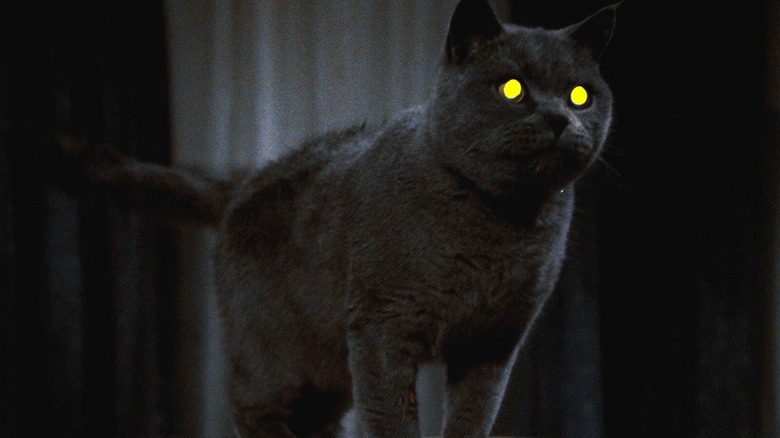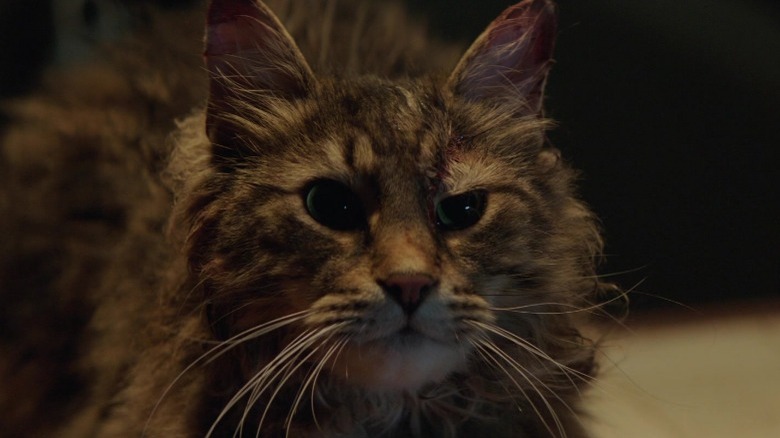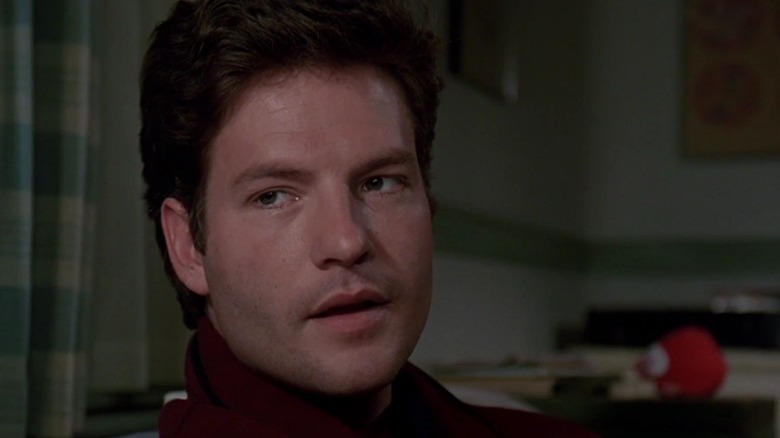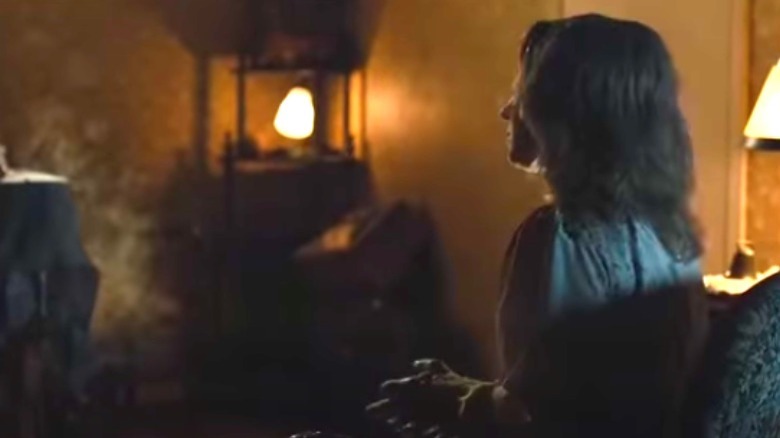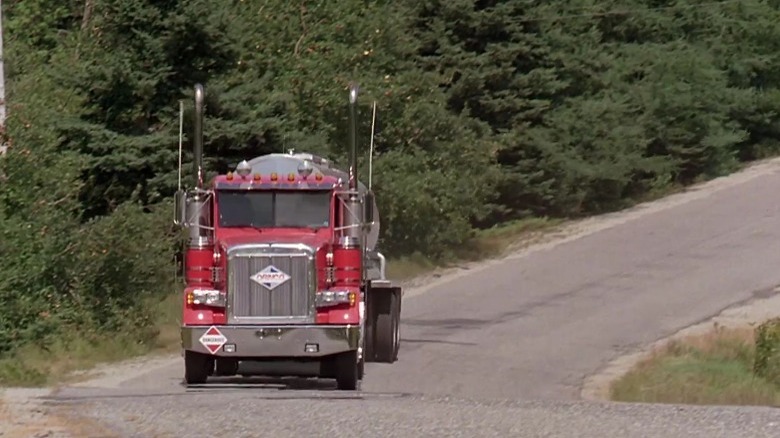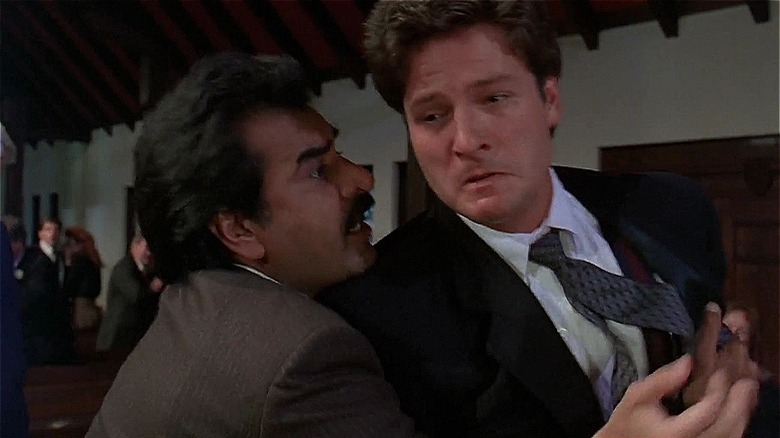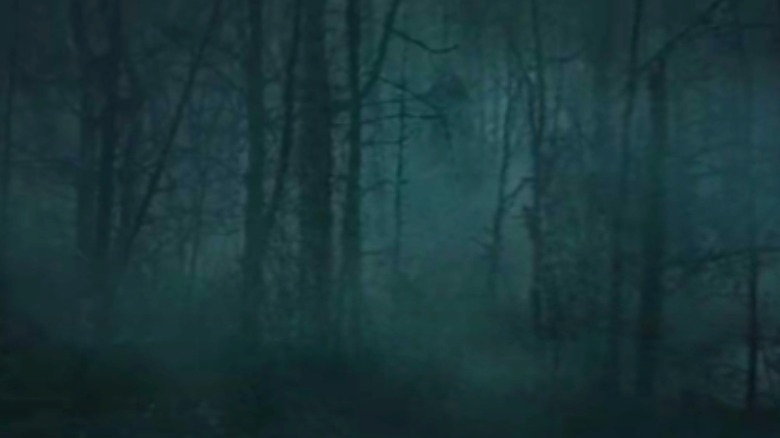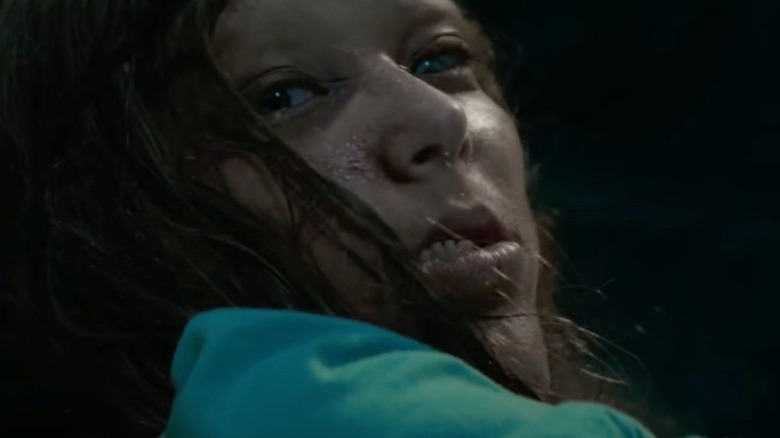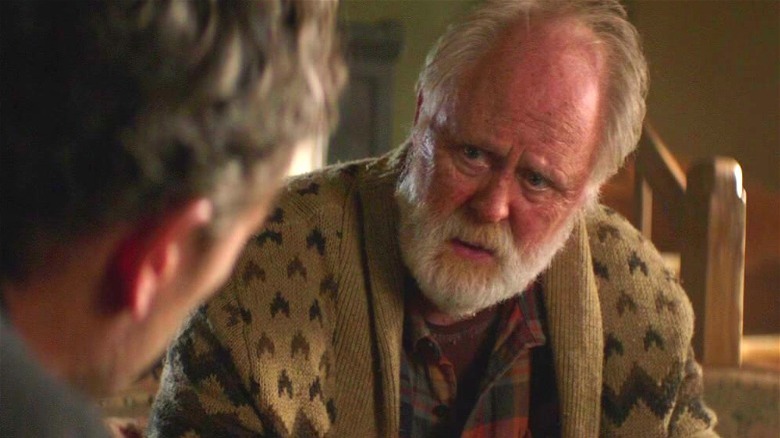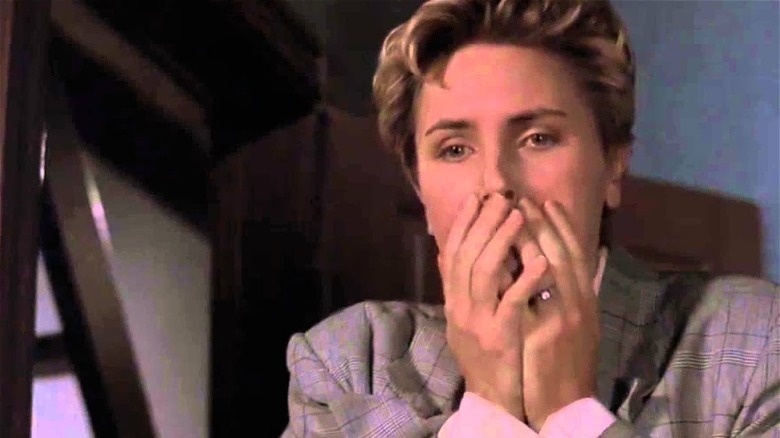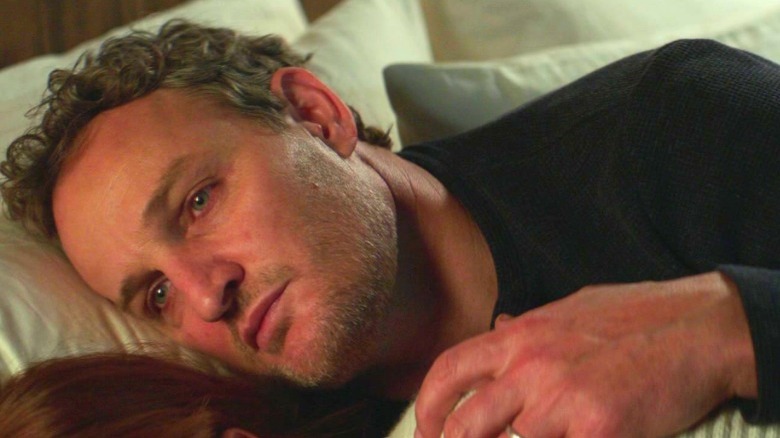Disturbing Pet Sematary Moments From The Book Cut From The Movies
In the canon of Stephen King's horror stories, the 1983 novel "Pet Sematary" stands out as one of his more meditative tales as it delves into themes of death, loss, and grief. The story follows the Creed family as they resettle from Chicago into rural Maine, where they cross paths with a malevolent force living adjacent to their home in a pet cemetery with unusual properties. Told through the perspective of grieving father Louis Creed, the novel lingers in the bargaining stage of grief, questioning what compromises anyone might be willing to make if it meant bringing back a lost loved one.
The haunting tale has been adapted twice for the big screen — in 1989 and again in 2019. As with any retelling, each version allowed filmmakers a chance to explore different elements of the source material while offering a fresh take on its themes. But like every Stephen King adaptation, some details from the original tale got left on the cutting room floor whether they were just too unsettling or too difficult to convey onscreen. Grab your shovel and get ready to hike because we're digging up the most disturbing "Pet Sematary" moments that didn't make it into the films.
Zombie Church
In this tale about a cursed cemetery, it makes sense that the family pet would play a central role in the storytelling. For the Creed family, their beloved cat Winston Churchill, aka "Church," serves as a canary in the coal mine for the household's relationship with the unholy burial ground looming in the woods near their home. In the novel, the family feline — technically Ellie's cat — is first introduced on the trip to Ludlow, having spent the drive from Chicago pacing restlessly.
As depicted in both films and the book, Church's death introduces the burial ground when he gets run over by a truck and subsequently revived by Jud. In the films, Church's zombified nature is mainly depicted through hissing and scratching. Although both films mention Church's unearthly odor, aside from rather rudely tossing a rat into Louis' bathtub in the 1989 film for reasons only a zombie cat can understand, most of Church's onscreen postmortem behavior is indiscernible from that of a feral cat.
The Church in the novel is much more disturbing as the book depicts his post-life activities in gory detail. After the cat returns covered in blood and pieces of the trash bag he's buried in, Louis is so grossed out that he breaks out in goosebumps, finding the animal repulsive. Perhaps most abhorrent is the book's description of Church noshing on a dead crow's "milky, glazed" eyeball.
Louis' reaction to Gage's body
One of the things that makes master of horror Stephen King's writing stand out is the author's ability to write deeply flawed but beautifully fleshed-out characters, sharing their innermost thoughts in often cringe-inducing detail. As told through the perspective of family man and disillusioned doc Louis Creed, "Pet Sematary" is peppered with insights on the various frustrations and anxieties of family life that will feel familiar to anyone who's read or seen "The Shining." And much like doomed dad Jack Torrance, Creed's active inner monologue vibrates with imagery whether he's daydreaming of becoming a doctor at Disney World or comparing his recent house purchase to Julius Caesar's omens. Although it's a shame this almost cartoonish side of Louis doesn't translate well into the films, it spares viewing audiences gory details when spurred by his grief, he digs up his son Gage's body with plans to replant it in the ground.
Although Gage doesn't die in the 2019 film, the 1989 film serves up a fairly G-rated retelling, which consists mainly of Louis peering into the casket before scooping up the boy. At first, we see the back of the child's blonde head, with Louis bundling the child in a blanket before taking him to the Wendigo grounds. Told through Louis' perspective, the book scene is much more grisly beginning with its vivid description of the vomit-inducing decomposition smell. Comparing the child to a doll, the book describes his body in excruciating detail — details that the films gratefully omit.
Norma's death
When Louis first meets Jud in the book "Pet Sematary," he comes as part of a package deal along with his wife, Norma. As Norma suffers from a number of health conditions including rheumatoid arthritis, Louis helps with her medical care toward the end of her life until she finally succumbs to a heart condition. Her life shows Jud's softer side, while her eventual death serves as a reminder that all lives have a natural cycle and part of that means eventually having to say goodbye.
Despite Norma's important place in the novel, she is almost completely omitted from the films. In the 1989 version, hurtful details about Norma are uttered to Jud by a possessed Gage toward the end, but her presence in the community is replaced by the family's housekeeper, Missy Dandridge. Like Norma, Missy suffers from a painful chronic disease, although in her case it's stomach cancer. While her death by suicide also represents a shocking loss for the Creed family, the emotional connection the family had with Norma just isn't there and she arguably does not nearly fill the shoes of the grandmotherly neighbor. In the 2019 film, Norma is there in spirit only, having died months prior to the Creed family's first encounter with Jud, now a widower. A deleted scene from the 2019 film on the Blu-Ray explores Norma's story further, but the storyline was ultimately cut from the film.
Timmy Baterman's return
Although Church's and Gage's returns from the dead make up the ghastly central action of "Pet Sematary," they're by no means the first living beings to emerge from the tale's unhallowed ground. One such returned figure that should have been enough to scare Jud off the Wendigo grounds altogether (but inexplicably wasn't) is Timmy Baterman. As described in the novel, Timmy is a young soldier who gets killed in Italy only to be revived by his grieving father, who swiftly comes to regret the decision.
In the 1989 film, Timmy's story is told through flashback clips as Jud recounts the tale to Louis. In this version, the boy is depicted as an animalistic, speechless creature who roams around eating dead things and frightening the locals until a group of them burn him alive. While this Timmy is pretty frightening, he's a little like the Wendigo-possessed Timmy from the book. Although the novel describes Baterman as slow and shambling "like a zombie in a movie," Jud makes a point of emphasizing, "There was somethin' more," an intelligence Jud describes as a sort of call from the beyond. Besides stumbling around town and looking generally frightening, Timmy reveals the townsfolks' secrets and even makes a pass at Mrs. Stratton — more like another iconic King character, Randall Flagg. The 2019 film, which depicts Timmy as a Vietnam vet, comes closer to this version, although most of the details are told rather than shown.
Gage's death
Inspired by a near-miss with Stephen King's own son Owen, Gage's unimaginable death by semi-truck is the distressing impetus behind every horror to follow in "Pet Sematary." In the book, Gage's death is not told chronologically. Instead, it's relived through Louis's flashbacks after the book skips ahead from a particularly sweet kite-flying scene to the dark days surrounding Gage's funeral. The fatal accident is one Louis recalls in excruciating detail as he goes over it again and again in his mind, ruminating over the what-ifs that might have saved the boy's life, comparing the possibilities to a Rube Goldberg machine. It's later revealed that the Orinco driver was completely sober during the accident and had no prior speeding violations but just had the compulsion to speed up — a hint that he may have been influenced by the dark power of the Wendigo's home turf.
In the 1989 film, the graphic details are mostly omitted as Gage's death is shown through a distracted truck driver, the horrified reactions of his family, an overturned semi, and a thrown-off shoe. In the 2019 film, it's actually Ellie who dies when a truck overturns to avoid hitting Gage, instead sliding into the girl. As with the 1989 film, the moment is revealed through the events surrounding it rather than graphically revealing the horror of a child's death.
The funeral fight
Grief can be brutal, especially when that grief revolves around the untimely loss of a child. For the Creed family, that raw grief dredges up some long-standing hard feelings between Rachel's husband and father leading to an ugly physical confrontation during Gage's viewing at the funeral parlor. Angry and blaming Louis for his grandson's death, Rachel's dad screams at his son-in-law in the book, "Where were you when he was playing in the road?" The two men start fighting, and in the ensuing chaos, Gage's "dwarf coffin" is rather symbolically knocked to the floor.
Although his body doesn't fall out, enough does that Louis sees enough of Gage, adding to the horror of the moment described as "a final bit of outrageous gothic melodrama which shattered whatever remained of Rachel's fragile self-control." Moved from the viewing to the funeral proper for emphasis, the scene is depicted faithfully to the book in the 1989 film as the two men turn Gage's funeral into a tangle of outwardly projected grief and blame, knocking over the casket in the melee. However, it's completely omitted from the 2019 version, which offers very little insight into the family's troubled relationship with Rachel's parents.
The Wendigo's appearance
Viewers familiar with "Pet Sematary" only from the 1989 film could be forgiven for failing to understand one crucial detail: that a Wendigo is behind all of Ludlow's horrors. In the novel, Louis first learns of the Wendigo legend while laying Church to rest in the Mi'kmaq burial ground. As they trudge through the woods, Jud ominously recounts that "Later on, not even the Micmacs themselves would come here. One of them claimed he saw a Wendigo here and that the ground had gone sour." Although Jud seems dismissive of the claim, the book goes to great lengths to emphasize that he and Louis definitely hear something in the woods while they're out burying the cat, something that causes Louis momentary unease before suddenly shifting away from them.
Jud later reveals more about the Wendigo legend, including a certain cannibalistic aspect to the story. It's a story that Louis eventually comes to accept as he dreams he is "the father of cannibals" visited by a titanic horned beast with "cracked reptilian yellow" skin and "great hooded foglamps" for eyes. When the dead rise, they're not themselves because they are inhabited by the spirit of the Wendigo. While the creature is sadly left out of the 1989 film, he is discussed at length in the later adaptation, and his shadow can even be seen lurking in the woods in one scene.
Zelda's death
In both "Pet Sematary" films and the book, the death of Rachel's sister Zelda remains with her as a lingering pain long after she is buried. In the novel, Rachel recounts how her family kept Zelda locked away in a back room as she slowly died from spinal meningitis. As Rachel describes her family's emotional trauma as her sister's body wasted away, shriveling, and strung out on palliative medication, she tells Louis that the family wished her dead to end all of their collective sufferings. Rachel was home alone with her on the day that she died, a horribly traumatizing experience for an eight-year-old girl. The image continues to haunt her long after Zelda's death, with Rachel dreaming up creatures coming to eat her, all of which looked like her sister.
Instead of letting the trauma of her death stand on its own, emphasizing Rachel's guilt and Zelda's suffering, both films infuse the Zelda flashbacks with horror elements. The 1989 version transforms Zelda into a distorted figure by using an adult male to portray the adolescent child. The 2019 adaptation takes things a step further and reimagines Zelda dying in a rather gruesome dumbwaiter accident. While both mention her spinal meningitis and make an honest effort at portraying Rachel's trauma, the simple horror of the child's wasting death detailed in Stephen King's book is frightening on a much deeper, more existential level than what's presented on screen.
Jud's supernatural motivations
From watching the film adaptations alone, it's easy to think Jud Crandall is a friendly but hapless neighbor who simply doesn't fully understand the level of evil at work on the Wendigo ground. But the novel includes many small moments that paint a more complicated picture of Jud's motivations as his behavior continues to contradict his understanding of the power the place has over the Ludlow community. Throughout the book, it's established that Jud fully understands the power of the burial grounds through their impact on all of the many creatures revived there. Besides Timmy Baterman, Jud recalls several other animals that come back wrong, particularly a prized bull named Hanratty that became very angry.
But there's one moment in particular where Louis imagines Jud with self-awareness about Wendigo's power over him. In a moment either recounted or imagined through Louis's stream of consciousness as he drinks himself into a stupor after Gage's death, Jud tells him people tell others about the place because they "want to share the secret," burying their dead there because they "make up reasons," because they "want to," and because they "have to." While the real Jud later shows up to warn Louis of the idea, there's no denying his revelation about the burial ground is the reason Louis revives his son.
The eerie ending
One of the most disturbing moments in Stephen King's horror novel is ironically one of the tale's subtler moments. As a horror legend, King knows better than most that sometimes the best terror is implied rather than graphically spelled out. "Pet Sematary" plays into this uncertainty with one of King's strongest — albeit most ambiguous — endings. After finally dealing with the mess he created by resurrecting Church and Gage, taking them out a second with his handy dandy morphine hypos, Louis decides to try again with Rachel, believing he took far too long with Gage, but things will be different this time. Luckily, Ellie is safely back in Chicago with her grandparents as things go completely off the rails back in Ludlow. The final scene finds Louis playing solitaire. He doesn't react as he hears Rachel's footsteps and her cold hand touches her shoulder, her gritty voice as she eerily greets him.
The films take a far less nuanced approach to the ending. Although Louis' intent on reviving her remains the same as it's portrayed in the book, the 1989 version brings back a Rachel who would look at home on "The Walking Dead." In the 2019 adaptation, every Creed but Gage is revived. The film ends with the zombified Creeds approaching the waiting toddler, apparently intent on making sure he joins their ranks.
Louis' supernatural makeover
From Jack Torrance's ballroom cocktails to Nadine Cross's desert hookup with Randall Flagg, coming into contact with supernatural forces tends to hit Stephen King characters hard. While the Louis portrayed in the "Pet Sematary" films is decidedly not quite himself by the end of the movies, the onscreen versions gloss over how dramatically his Wendigo interactions make him over both physically and mentally.
The extent of his transformation is described through the eyes of his colleague Steve, who encounters Louis as he's carrying a dead Rachel to the burial ground. Under the spell of the Wendigo, Steve feels a strange compulsion to aid him in the endeavor despite this. Equally strange is his observation that Louis' hair has turned completely white and his face suddenly resembles that of an extremely old man. Steve later reflects that Louis had become deeply unstable, an observation that's supported by Louis' nonchalant solitaire game as he waits for his dead wife to finish resurrecting.
With this supernatural makeover, Louis joins the ranks of several Stephen King characters whose hair turns white after a brush with the dark side. The same fate befalls Henry Bowers after his encounters with Pennywise in "IT." And Nadine Cross's long hair also turns white after consummating her relationship with Randall Flagg in "The Stand."
